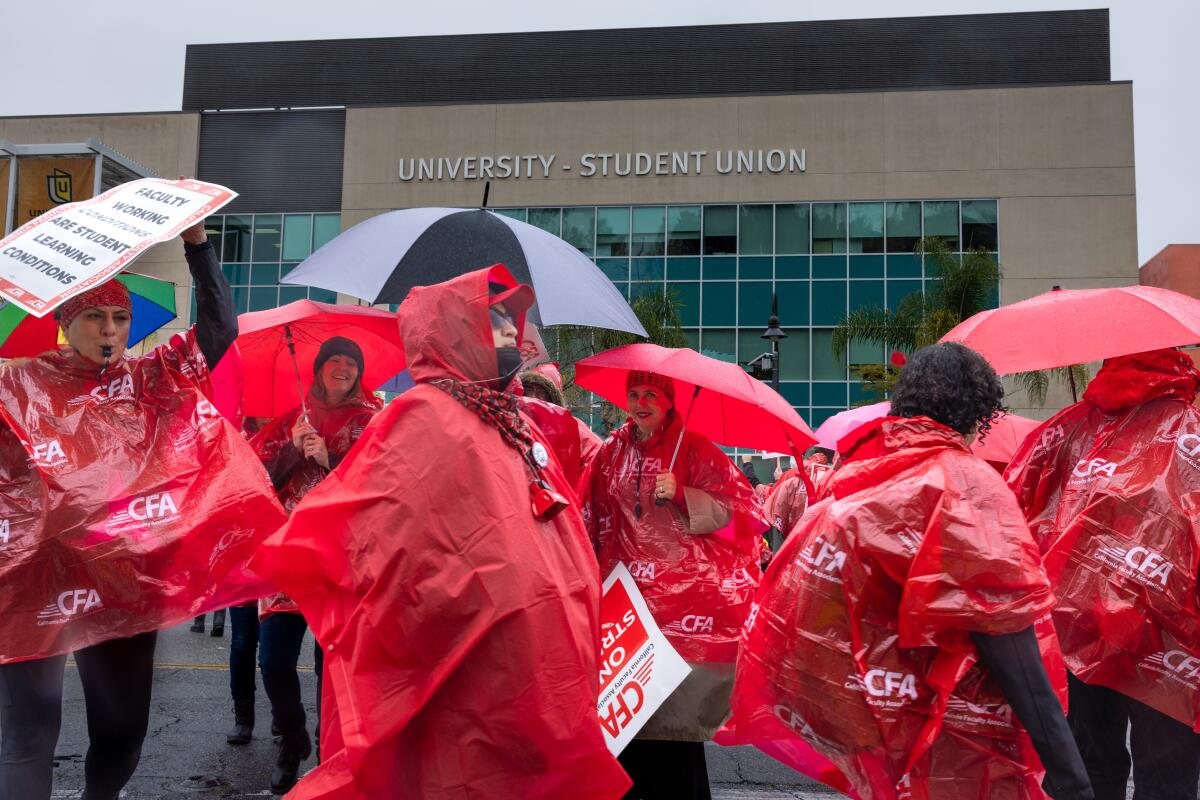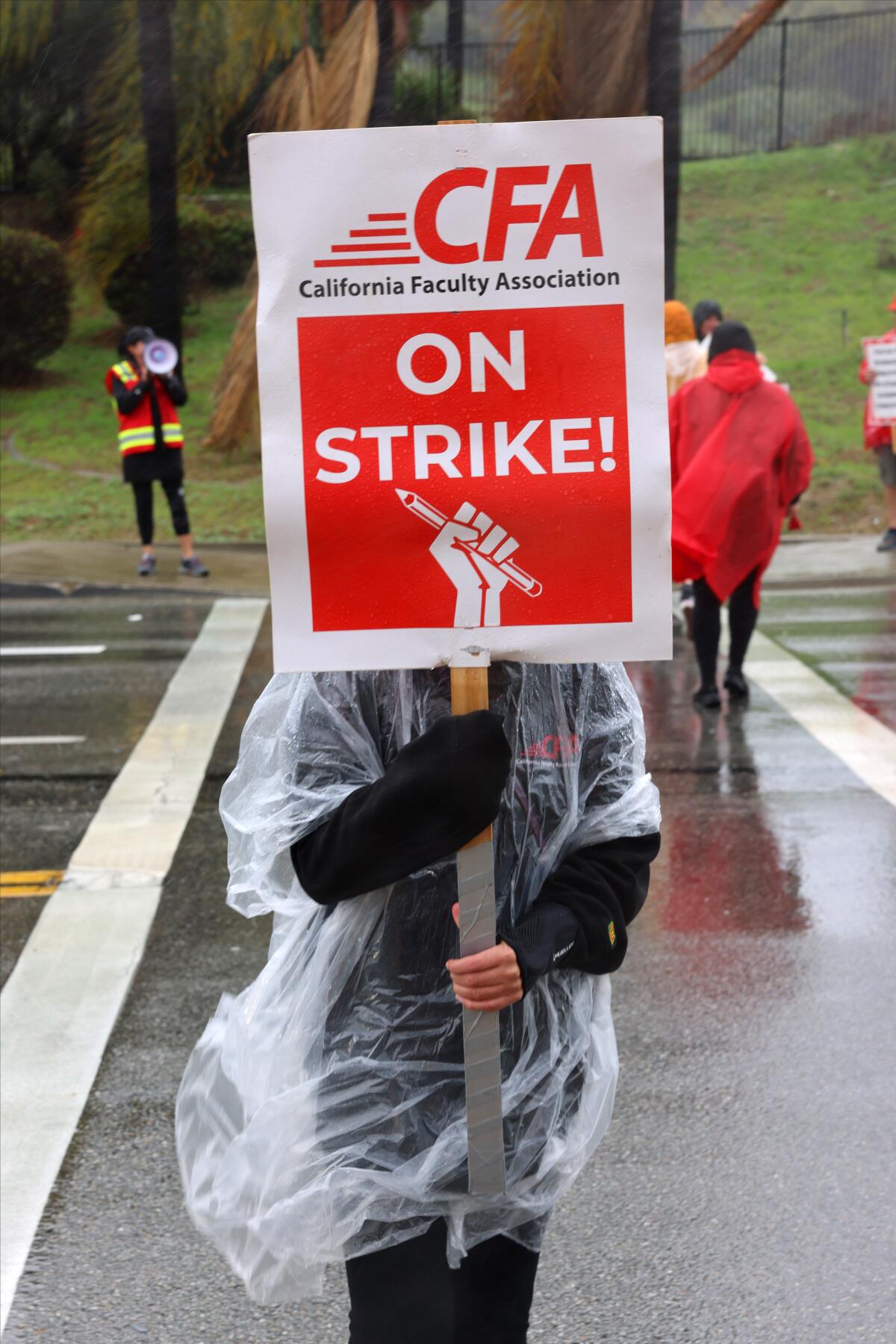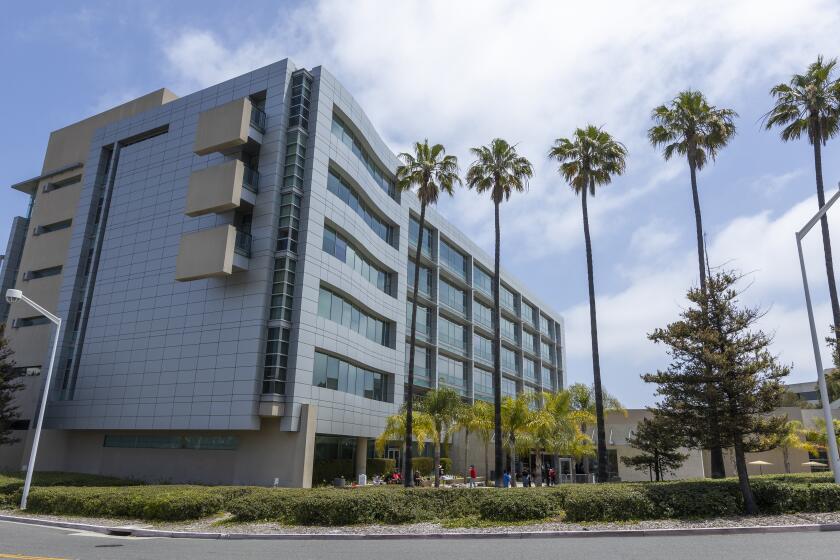Thousands of CSU faculty vow to ‘shut down’ campuses in first systemwide strike

- Share via
The union representing 29,000 faculty members at California State University, the nation’s largest four-year public university system, walked off the job for five days Monday, disrupting the first week of the spring semester for tens of thousands of students.
The systemwide strike of professors, lecturers, counselors, librarians and coaches, who are demanding a 12% wage increase and other benefits, is the first ever across all of CSU’s 23 campuses. As faculty members at Southern California campuses began picketing in the morning rain, the strike added to the frenzy of the first days of classes, a time when students typically make last-minute adjustments to schedules and professors review syllabi and outline class expectations.
“Our intention is to shut down the university,” said Gregory Brown, president of the Cal State Fullerton chapter of the California Faculty Assn. “The CSU is not paying us what we deserve. We know for a fact that we have faculty that are food unstable, housing unstable. Some of our faculty members come to campus to use the internet, because they can’t afford to pay.”
Campuses will remain open during the strike. Any changes to when and how instruction is delivered are up to faculty members, who are “responsible for assuring that students meet the learning outcomes for the courses they teach,” said Amy Bentley-Smith, a Cal State spokesperson.
“The CSU is communicating with students that campuses will be open to provide services to students and to check with their professors about class schedules during the strike, as not all faculty will choose to go on strike,” she said in a statement.
Cal State Los Angeles, typically bustling on the first day of classes, was mostly empty Monday morning. At Cal State Fullerton, usually jammed parking structures had plenty of spaces. Fliers had been dropped around a student gathering area on the Fullerton campus encouraging people to “Support the Strike! ... Join the picket lines!”
On this first strike day, students were navigating a dizzying mix of instructions: Classes are canceled, classes are temporarily on Zoom, class is in session.
“For the majority of students, there’s a feeling of not wanting to cross the line,” said Ahsley Gregory, who protested alongside Cal State L.A. faculty. “This is a fight that’s going to benefit all of us.”
Jordyn O’Connell, a psychology major and student worker at the all-but-empty Cal State L.A. Starbucks, said she supports the strike even though it means all her classes are canceled for the week. She plans to use the extra time to get ahead on course readings.
“I’ve been really eager to get back,” she said. “I just hope that we get this figured out. I’m ready to start the semester.”

The turmoil will be a major test for recently installed Chancellor Mildred Garcia, who is recognized for raising achievement among Latino students and improving graduation rates when she was president at Cal State Fullerton. She has taken over at a fraught time, when the system is under harsh scrutiny for its handling of widespread sexual misconduct among top administrators and is beleaguered by finances that prompted a 6% tuition hike in September.
“Let me assure you, as a new chancellor four months into the job, I have no interest in a strike. We are ready and willing to come back to the bargaining table with the California Faculty Assn., but we must work within our financial realities,” she said in a recorded briefing Friday.
A report found flaws in the Cal State system’s data collection on sexual harassment and sexual misconduct cases and cited wide distrust by students and employees.
In addition to the faculty unrest, more than 4,000 non-academic student workers in jobs from IT support to receptionists are in the final stages of a union organizing campaign. On Friday, the university reached a tentative agreement on a three-year contract with the Teamsters Local 2010 Union, representing 1,100 skilled trade employees, who called off a strike that was also planned for Monday.
The CSU strike comes about a year after 48,000 University of California academic workers, teachers assistants, researchers and postdoctoral scholars roiled that nine-campus system by walking out for about five weeks, ultimately winning significant improvements of wages and working conditions. Their strike was seen as a precursor to a surge of union activism in higher education.
How did CSU faculty reach this point?
The CSU strike has been building for about eight months. In May, the faculty union began “reopener bargaining,” in which both sides negotiated sections of the current contract, which ends in June. As negotiations lagged, the union staged a one-day walk-out in December at Cal Poly Pomona, San Francisco State University, Cal State L.A. and Sacramento State University.
The union is seeking substantial pay increases. Its members have demanded a 12% across-the-board raise for all faculty and an increase of the minimum salary to $64,360 from $54,360. They have also pushed for other improvements, including smaller class sizes, the extension of parental leave to a full semester and gender-inclusive bathroom spaces.
The two sides remain divided on pay. The union says 12% across-the-board raises for 2023-24 and base increases for its lowest-paid workers are necessary for faculty to keep up with rising costs. Many lecturers and counselors, or faculty members who work on a contract basis and are not eligible for tenure, say they must string together work on multiple campuses or take on debt to pay for basic necessities.
The union has said its salary proposal would cost about $364 million annually, which it insists Cal State can afford by dipping into reserves. An Eastern Michigan University professor who was commissioned by the union to conduct a study of CSU found that it is in a healthy financial position with “a high level of reserves.”
But CSU officials have contested the union’s findings, arguing that they must maintain financial reserves for emergencies and are not permitted to use some of the money the faculty association identified for pay.
After the sides reached an impasse in October, an independent fact-finder recommended that the system give faculty a 7% increase. The report failed to bring the sides closer together, and CSU ended contract talks and unilaterally imposed a 5% pay bump for faculty, effective Jan. 31. The raise aligned with increases the system recently gave to employees in several other unions representing CSU workers.
Leora Freedman, vice chancellor for human resources, said in a statement that CSU was committed to “paying fair, competitive salaries and benefits” but must “operate within our means to protect the long-term success and stability of the university, our students and our faculty.”
Charles Toombs, president of the California Faculty Assn., lambasted CSU’s decision to end negotiations as “disrespect from management.”
What will the strike mean for students and instruction?
The strike unfolds at what is usually a busy time on campus, the start of a new term.
About 100 faculty members in red ponchos picketed in pouring rain near an entrance to Cal State Fullerton.
“Surprisingly, for the first day, there’s a lot of parking all over campus,” said Michele Barr, a kinesiology lecturer. “The purpose of the strike is to create disruption. It is not business as usual.”
Barr said she had emailed her students ahead of the strike to explain why she was walking out.
“We are so behind inflation,” she said, as cars honked in solidarity. “Not only are we losing really great faculty, we can’t even hire people. That’s a sad thing because the mission of the CSU is affordable, quality, accessible education for everybody, but you can’t do that without faculty.”
Tracey Salisbury, chair of the ethnic studies department at Cal State Bakersfield, said she typically spends the first week of the semester holding meetings with her department, helping students navigate logistical needs such as paying tuition and setting up the online platform where students can access course discussions and assignments.
In recent weeks, she contacted students to inform them about the strike and advised faculty in her department to do the same.
“We’re doing it in support of them — to make sure that they have the best teaching conditions, learning conditions, by having their faculty be prepared and properly compensated for the work that they do,” said Salisbury, the Cal State Bakersfield chapter president of the California Faculty Assn. “Our No. 1 priority is making sure that they receive adequate notice to know that some faculty will not be engaging in any labor at all.”
What about other CSU employees?
CSU has reached contract agreements in recent months with several other unions, including those representing support staff, nurses, custodians, academic student employees and campus police.
Jason Rabinowitz, secretary-treasurer of Teamsters Local 2010, which reached an agreement last week, said its members would not strike alongside faculty, as had been planned. But the union “wholeheartedly supports CSU Faculty in their fight for a fair contract,” he said in a statement.
Later this week, Cal State non-academic student workers are expected to hold a vote on unionization. If successful, the union would be the country’s largest to represent nonacademic undergraduate student employees, according to the Cal State University Employees Union, which hopes to add the students to its membership rolls.
More to Read
Sign up for Essential California
The most important California stories and recommendations in your inbox every morning.
You may occasionally receive promotional content from the Los Angeles Times.












